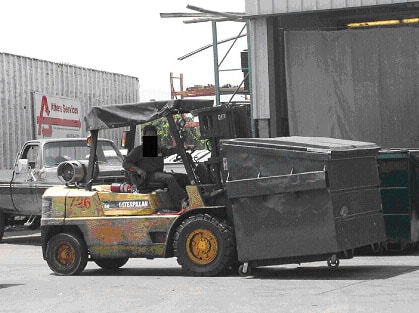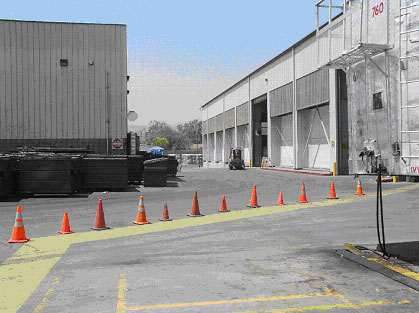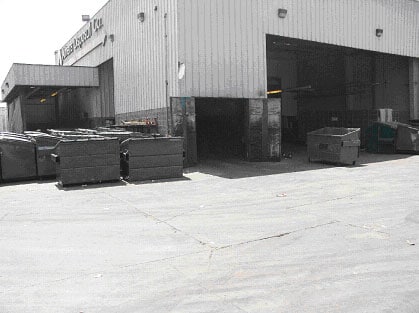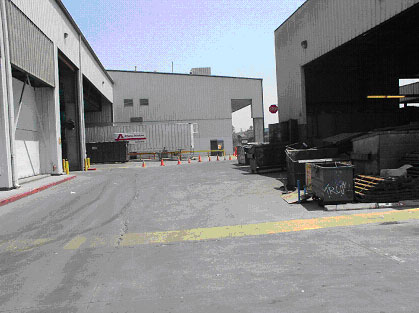A Hispanic Female Laborer Was Run Over By A Forklift That Was Moving A Trash Bin In A Waste Transfer and Recycling Station
Investigation: # 02CA008
SUMMARY
A Hispanic female laborer, working as a trash sorter, was run over by a forklift at a waste transfer and recycling station. The forklift operator was moving a trash bin with the forklift and was traveling in a forward direction. The load he was carrying when the incident occurred blocked the forklift operator’s forward vision. The victim was walking in an area that was not intended for pedestrian traffic. The operator was not formally trained for the forklift he was operating. The CA/FACE investigator determined that, in order to prevent future occurrences, employers, as part of their Injury and Illness Prevention Program (IIPP) should:
- Ensure all employees who operate forklifts are formally trained, licensed and retrained as required.
- Ensure forklift operators’ vision is not obstructed in the direction of travel.
- Ensure employees, when walking to and from different work locations, only walk only in designated areas.
INTRODUCTION
On September 13, 2002, a Hispanic female laborer was run over by a forklift moving a large trash bin at a trash disposal site. The CA/FACE investigator learned of this incident on September 19, 2002, through the Legal Unit of the Division of Occupational Safety and Health (Cal/OSHA). On October 28, 2002, the CA/FACE investigator traveled to the victim’s place of employment where he interviewed the company’s safety administrator and viewed the incident scene. On April 28, 2003, a follow-up investigation took place where more information was obtained and witnesses to the incident were interviewed. A copy of the police report showed five employees were interviewed as witnesses to the incident. All witness statements to the police required a Spanish translator.
The employer of the victim was a trash recycler that had been in business for over 50 years. The company had approximately 1,000 employees. The location where the victim worked had approximately 550 employees working three shifts. The shift the victim worked on had 160 employees. The victim had been employed with the company for 4 years and had worked at the incident site the entire time. The operator involved in this incident was hired less than a year before the incident. The employer of the victim had a written safety program. Safety meetings were held weekly in both English and Spanish but were not documented. The company had a training program for the employees. Training and certification were required for forklift operators and operator’s proficiency was measured through observation. The insurance carrier for the company provided the training by training the trainer annually. The trainers then trained the employees annually. Documentation for the forklift operator training was available for all forklift operators except for the one involved in this incident. He had not been formally trained on the forklift he was operating. He was observed to be proficient by the supervisor, but the documentation was never completed.
INVESTIGATION
The site of the incident was a transfer and recycling facility for trash and waste. The facility consisted of two large buildings with a driveway in between them and a marked walkway on the driveway (exhibits 2 & 4). The first building faced north and had soundproof walls. It was used to sort and transfer waste product from conveyor belts to container trucks and bins. This was the building where the majority of employees worked. A second building faced west and was located to the rear and east of the first building. This building was used to facilitate the repair of the trash and recyclable containers. The break room was located adjacent to the west side of the second building and the restrooms were located in the center of the first building. Yellow striping on the pavement designated a walkway for employees to follow when going to the restroom or break area. The walkway followed the perimeter of the first building, and then crossed over at the break area. On the day of the incident, the victim was walking from the restroom to the break area. Instead of following the designated walkway, she cut across the driveway.
The forklift operator was transferring a container from the yard to the repair shop located in the second building. His normal path for this activity was hindered by a large piece of machinery stored next to the north side of the second building, so he had to swing out wide and go around this barrier. As he came around the stored piece of machinery, he was traveling in a forward direction with his view obstructed by the trash bin on the forks. A witness stated that as he was walking from the break room to the men’s room, he saw the forklift making a wide turn traveling forward with a large trash bin on the forks. The victim was walking in the roadway facing away from the approaching forklift. As the forklift approached the victim, the middle of the trash bin on the forks hit the victim in the back and she fell to the ground. The forklift operator kept on going forward, pinning the victim under the trash bin.
Another employee told police he was standing on a platform to the right of the incident scene and saw the forklift operator looking forward as he began making a wide turn. He stated he saw the forklift hit the victim and drag her approximately 10 to 15 feet before stopping. When the paramedics arrived the victim was unconscious, with depressed vitals, and with trauma to her chest and back. She was transported by ambulance to another location then airlifted from that scene to the hospital where she was pronounced dead.
CAUSE OF DEATH
The cause of death, according to the death certificate, was blunt abdominal trauma.
RECOMMENDATIONS/DISCUSSION
Recommendation #1: Ensure all employees who operate forklifts are formally trained, licensed and retrained as required.
Discussion: Employers are required to ensure that each forklift operator is competent to operate the equipment safely. This can be accomplished through training that consists of a combination of formal instruction, practical training and evaluation of the operator’s performance in the workplace. The training program must consist of related topics that are applicable to the safe operation of the forklift such as visibility, pedestrian traffic, and other unique or potentially hazardous conditions that could affect safe operation. The employer deemed the forklift operator involved in this incident qualified to operate after he was hired, however, the documentation necessary to verify this training was never completed. Documentation is required to verify all aspects of required training and allows employers to track and schedule re-training when required. Retraining of forklift operators must also be conducted every time an operator is involved in an accident or observed operating in an unsafe manner.
Recommendation #2: Ensure forklift operators’ vision is not obstructed in the direction of travel.
Discussion: One of the many responsibilities a forklift operator has is to be constantly aware of their surroundings. Conditions in the workplace change and operators must have unrestricted visibility in the direction of travel. When the load that is being carried restricts visibility, the forklift must travel in reverse to regain that visibility. Had the load the operator was carrying not restricted his visibility, this incident might have been prevented. Use of safe practices can be ensured through supervision, training, rewards, and progressive disciplinary measures.
Recommendation #3: Ensure employees, when walking to and from different work locations, only walk only in designated areas.
Discussion: Pedestrian traffic in the workplace where forklifts and other equipment are being operated can create a hazardous condition. Even though areas may be marked as restricted for pedestrian traffic, unless corrective action is taken when violations occur, the unwanted behavior will continue. Use of safe practices can be ensured through supervision, training, rewards, and progressive disciplinary measures.
REFERENCES
California Code of Regulations, Vol. 9, Title 8, Sections 3650(s)(1)(9)(11)(12), 3668(a)(1)(3), (c)(1)(F)(D)(I), (d)(1)(A)(B)
FATALITY ASSESSMENT AND CONTROL EVALUATION PROGRAM
The California Department of Health Services, in cooperation with the California Public Health Institute, and the National Institute for Occupational Safety and Health (NIOSH), conducts investigations on work-related fatalities. The goal of this program, known as the California Fatality Assessment and Control Evaluation (CA/FACE), is to prevent fatal work injuries in the future. CA/FACE aims to achieve this goal by studying the work environment, the worker, the task the worker was performing, the tools the worker was using, the energy exchange resulting in fatal injury, and the role of management in controlling how these factors interact.
NIOSH funded state-based FACE programs include: Alaska, California, Iowa, Kentucky, Massachusetts, Michigan, Minnesota, Nebraska, New Jersey, New York, Oklahoma, Oregon, Washington, West Virginia, and Wisconsin.
To contact California State FACE program personnel regarding State-based FACE reports, please use information listed on the Contact Sheet on the NIOSH FACE website. Please contact In-house FACE program personnel regarding In-house FACE reports and to gain assistance when State-FACE program personnel cannot be reached.
EXHIBITS
 |
| Exhibit 1. Picture of a forklift transporting a trash bin similar to the one involved in this incident. |
 |
| Exhibit 2. A view of the incident scene standing at the restroom door looking south. |
 |
| Exhibit 3. A view of the incident scene looking east. The incident occurred in the middle of the roadway. |
 |
| Exhibit 4. A view of the incident scene standing at the break room looking north. |
